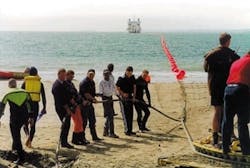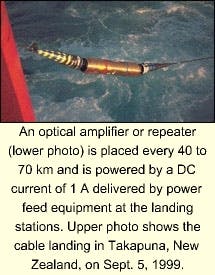Southern Cross Cable Network takes Australia to the heart of the Internet
On November 15, 2000, after nearly three years of planning, installing, commissioning, and testing, the Southern Cross Cable Network went live as customers received access to their individual circuits. The undersea fiber-optic network connects Australia and New Zealand to the United States-the heart of the Internet-via three self-healing SDH rings, which deliver 120 times the capacity of the existing PacRim link between the two continents.
"Australia is one of the most connected countries in the world," says Andrew Riddle, vice president of marketing at Southern Cross. "We were seeing a rollout of cable modems and DSL technologies in Australia; the only missing part was the international segment, and that's why we built the Southern Cross Cable Network. It's designed to take Australia directly into the heart of the Internet by taking the most direct route we could across the Pacific."
The network itself is nearly 31,000 km around and consists of two separate cables that form a figure-eight configuration. The northern portion of the network, a collapsed fiber ring which runs from Australia to Fiji, from Fiji to Oahu, HI, and from Oahu to Hillsboro, OR, consists of four fiber pairs. Each fiber has been wave-division multiplexed to provide 2.5-Gbit/sec capacity over 16 wavelengths, for a total of 40 Gbits/sec per fiber pair or 160 Gbits/sec.The southern portion of the network is a fully protected fiber ring that runs from Australia to New Zealand, from New Zealand to the big island of Hawaii, and from Hawaii to Morro Bay, CA. This ring comprises three fiber pairs that provide a total capacity of 120 Gbits/sec.
A 1,500-km land route from Oregon to California links the separate rings. The network also includes an interisland link from Oahu across to the big island of Hawaii and another link across Sydney. Six existing cable stations were upgraded, and three were built from scratch for a total of nine stations in five jurisdictions-two each in Australia, New Zealand, Hawaii, and the U.S. mainland, and one in Fiji.
The Southern Cross Cable Network features path-switching technology to ensure customer capacity is always live by transmitting traffic simultaneously a round both sides of the network for fully protected capacity. According to the company, the network boasts a 99.999% reliability rate, which translates into 50 minutes of network downtime every 10 years.
The 28,500-km undersea segment was laid over the course of a year using seven cable ships. Each cable ship followed a very precise, predetermined route, the result of a thorough examination of the ocean floor. The cable was either buried via plough-burial or surface-laid. Wherever possible, the cable was buried in water depths of less than 2,000 m; the cable laid in the Kermadec Trench between New Zealand and Hawaii is, at 7,585 m, the deepest portion of the network.In October 1998, a consortium of Alcatel (Paris) and Fujitsu (Tokyo) won the $800-million contract to supply the hardware and software for the Southern Cross Cable Network. Alcatel provided the cable, some of the repeaters, and all of the terminal equipment for the landing stations, including the SDH transmission equipment and an end-to-end network-management system. Fujitsu supplied the remainder of the repeaters or underwater amplifiers.
Riddle admits that the network installation was not without its problems, one of which resulted in the relocation of a landing point from California to Nedonna Beach, OR, and the creation of the 1,500-km land route between the original site of the landing point and the new one. The network is currently in service with a figure-six configuration, as the last link between Morro Bay, CA, and Spencer Beach, HI, has yet to be completed. However, this section is expected to be operational at some point this quarter.
While there are no concrete plans to upgrade in the near future, the company expects to sell the network quickly, possibly within two years, which would necessitate an additional cable sequence. For the time being, however, the company's engineers are focusing their research on delivering traffic at a 10-Gbit/sec rate rather than at 2.5 Gbits/ sec. Tests are currently underway.
The network operates as an independent bandwidth wholesaler and is the brainchild of Southern Cross Cables Ltd. (Bermuda), a consortium of Telecom New Zealand (50%), Cable & Wireless Optus (40%), and WorldCom (10%).

